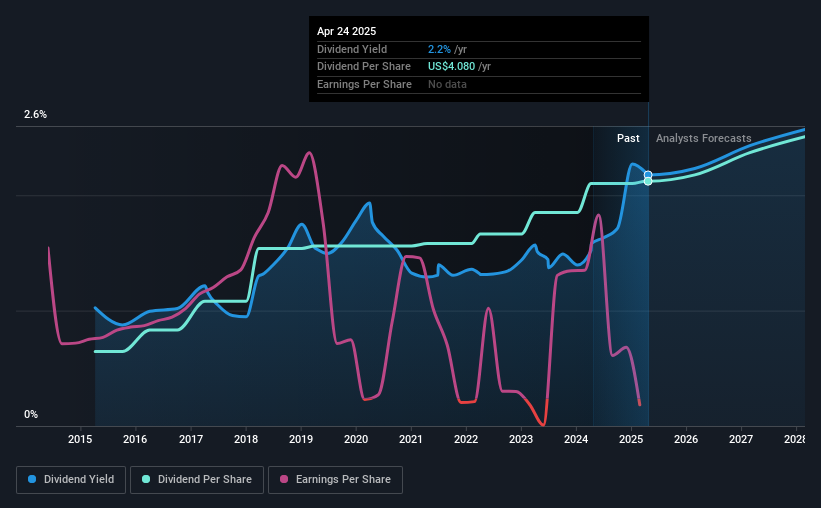Read This Before Considering Constellation Brands, Inc. (NYSE:STZ) For Its Upcoming US$1.02 Dividend
It looks like Constellation Brands, Inc. (NYSE:STZ) is about to go ex-dividend in the next three days. The ex-dividend date occurs one day before the record date, which is the day on which shareholders need to be on the company's books in order to receive a dividend. The ex-dividend date is an important date to be aware of as any purchase of the stock made on or after this date might mean a late settlement that doesn't show on the record date. Accordingly, Constellation Brands investors that purchase the stock on or after the 29th of April will not receive the dividend, which will be paid on the 15th of May.
The company's next dividend payment will be US$1.02 per share. Last year, in total, the company distributed US$4.08 to shareholders. Last year's total dividend payments show that Constellation Brands has a trailing yield of 2.2% on the current share price of US$187.50. Dividends are an important source of income to many shareholders, but the health of the business is crucial to maintaining those dividends. So we need to investigate whether Constellation Brands can afford its dividend, and if the dividend could grow.
Dividends are usually paid out of company profits, so if a company pays out more than it earned then its dividend is usually at greater risk of being cut. Constellation Brands reported a loss after tax last year, which means it's paying a dividend despite being unprofitable. While this might be a one-off event, this is unlikely to be sustainable in the long term. Considering the lack of profitability, we also need to check if the company generated enough cash flow to cover the dividend payment. If cash earnings don't cover the dividend, the company would have to pay dividends out of cash in the bank, or by borrowing money, neither of which is long-term sustainable. It distributed 38% of its free cash flow as dividends, a comfortable payout level for most companies.
View our latest analysis for Constellation Brands
Click here to see the company's payout ratio, plus analyst estimates of its future dividends.

Have Earnings And Dividends Been Growing?
Stocks in companies that generate sustainable earnings growth often make the best dividend prospects, as it is easier to lift the dividend when earnings are rising. Investors love dividends, so if earnings fall and the dividend is reduced, expect a stock to be sold off heavily at the same time. Constellation Brands was unprofitable last year, but at least the general trend suggests its earnings have been improving over the past five years. Even so, an unprofitable company whose business does not quickly recover is usually not a good candidate for dividend investors.
The main way most investors will assess a company's dividend prospects is by checking the historical rate of dividend growth. Constellation Brands has delivered an average of 13% per year annual increase in its dividend, based on the past 10 years of dividend payments. It's encouraging to see the company lifting dividends while earnings are growing, suggesting at least some corporate interest in rewarding shareholders.
Remember, you can always get a snapshot of Constellation Brands's financial health, by checking our visualisation of its financial health, here.
Final Takeaway
Is Constellation Brands an attractive dividend stock, or better left on the shelf? It's hard to get used to Constellation Brands paying a dividend despite reporting a loss over the past year. At least the dividend was covered by free cash flow, however. Overall we're not hugely bearish on the stock, but there are likely better dividend investments out there.
So if you want to do more digging on Constellation Brands, you'll find it worthwhile knowing the risks that this stock faces. Our analysis shows 2 warning signs for Constellation Brands and you should be aware of these before buying any shares.
Generally, we wouldn't recommend just buying the first dividend stock you see. Here's a curated list of interesting stocks that are strong dividend payers.
Have feedback on this article? Concerned about the content? Get in touch with us directly. Alternatively, email editorial-team (at) simplywallst.com.
This article by Simply Wall St is general in nature. We provide commentary based on historical data and analyst forecasts only using an unbiased methodology and our articles are not intended to be financial advice. It does not constitute a recommendation to buy or sell any stock, and does not take account of your objectives, or your financial situation. We aim to bring you long-term focused analysis driven by fundamental data. Note that our analysis may not factor in the latest price-sensitive company announcements or qualitative material. Simply Wall St has no position in any stocks mentioned.
 Wall Street Journal
Wall Street Journal